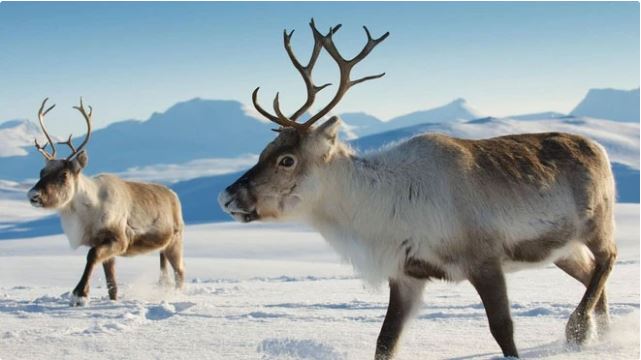Introduction: An Extraordinary Arctic Adaptation
In the heart of the Arctic tundra, where the sun barely peeks above the horizon for months on end, reindeer (Rangifer tarandus) have evolved an astonishing adaptation. These resilient creatures possess the rare ability to change the color of their eyes in response to seasonal shifts in light levels. This change is not merely cosmetic—it provides a crucial survival advantage in one of the planet’s most extreme environments.
The Science Behind Seasonal Eye Color Change
Reindeer eyes undergo a biological transformation between the harsh Arctic summer and the dim polar winter. Central to this transformation is a specialized layer in the eye known as the tapetum lucidum. This reflective layer, which lies behind the retina, enhances night vision by reflecting light back through the retina a second time.
In summer, the tapetum lucidum is a shimmering golden hue, optimized for the brighter, more abundant light. During the perpetual twilight of the Arctic winter, however, this layer shifts to a deep blue, a change that significantly improves the reindeer’s ability to navigate and forage in low-light conditions.
How Reindeer Alter Their Visual Sensitivity

This seasonal shift in eye color is a result of physical and structural changes within the eye. As winter approaches and sunlight diminishes, the pupils of the reindeer remain dilated for extended periods. This dilation increases the pressure inside the eye, causing collagen fibers within the tapetum lucidum to compress and scatter shorter wavelengths of light, particularly blue light.
This structural reconfiguration allows the reindeer to capture more light in the blue spectrum, which dominates the Arctic landscape during winter. This transformation boosts their night vision capacity by up to 1,000 times, giving them a sharp evolutionary edge in detecting predators and locating food sources under a sparse winter sky.
Enhanced Ultraviolet Vision: Seeing the Unseen
In addition to altering eye color, reindeer have evolved to see ultraviolet (UV) light—a capability absent in most mammals. The Arctic snow reflects UV radiation strongly, and this trait allows reindeer to perceive contrasts invisible to the human eye.
Objects such as lichen, a vital food source in winter, stand out sharply against the snowy backdrop in the UV spectrum. Similarly, predators like wolves or polar bears, whose fur absorbs UV light, appear as dark shapes on the glowing tundra, helping reindeer detect threats even when visibility is low.
Optical Evolution Driven by Polar Extremes
This extraordinary visual adaptation is a direct response to the polar extremes of light. In the Arctic Circle, winter brings continuous darkness, while summer brings continuous daylight. Unlike humans, who are heavily reliant on artificial light and circadian rhythms, reindeer have evolved to function seamlessly in this polar dichotomy.
Their visual system is specifically tailored for survival in conditions where sunlight may be absent for weeks or months. The change in the eye’s reflective layer is not a passive process—it is a dynamic and adaptive response to environmental stimuli.
Implications for Predator Detection and Foraging

The blue-tinted tapetum lucidum not only enhances light sensitivity but also allows reindeer to detect subtle movements in the snow—a critical advantage when predators approach. Additionally, their heightened UV vision enables efficient foraging, allowing them to distinguish edible vegetation from snow-covered terrain.
Reindeer often rely on lichen, a slow-growing plant that thrives in Arctic climates. In UV light, lichen reflects more radiation than snow, making it highly visible to reindeer and reducing the energy expenditure required to locate it during the energy-scarce winter months.
Interaction with Artificial Light and Human Infrastructure
While their enhanced sensitivity to UV light is beneficial in nature, it may have unintended consequences in areas exposed to artificial lighting. Infrastructure such as power lines and roads can emit UV radiation or disrupt natural light patterns, potentially disorienting the reindeer and altering their migratory behavior.
Studies have shown that reindeer tend to avoid areas with high UV output, including regions near overhead electrical wires. This avoidance could interfere with traditional migration routes and feeding grounds, posing new challenges in regions where human development intersects with reindeer habitats.
A Unique Evolutionary Feat Among Mammals
The reindeer’s seasonal eye color change is unparalleled among mammals. While some animals exhibit seasonal changes in fur or body fat, very few alter their internal anatomy in such a precise and functional way. This adaptation underscores the reindeer’s evolutionary ingenuity and their remarkable ability to thrive in environments that are otherwise inhospitable to large herbivores.
This optical adaptation also opens a window into the evolution of vision in extreme environments. By studying the reindeer’s eye, scientists can gain deeper insights into how light environments shape biological structures, potentially leading to biomedical innovations or improved low-light imaging technologies in human applications.
Conclusion: Nature’s Arctic Engineers
The reindeer’s ability to change the color of their eyes according to seasonal light levels is a vivid testament to nature’s engineering brilliance. In the frozen stillness of the Arctic, where survival hinges on perception and precision, visual adaptability becomes a lifeline. These magnificent creatures are not only icons of the North—they are models of evolutionary resilience, embodying the profound connection between biology and environment.
As our understanding deepens, the reindeer’s eye offers not just a glimpse into Arctic life, but also inspiration for advancements in optical science, environmental biology, and wildlife conservation. Their story reminds us that even in the harshest corners of the Earth, life finds a way—guided by the light in their eyes.
Keywords: reindeer eye color change, tapetum lucidum, Arctic adaptation, ultraviolet vision in reindeer, reindeer winter vision, blue eye reindeer, animal visual adaptation, polar wildlife, seasonal biological change, reindeer predator detection, UV sensitivity in animals, Arctic survival strategies.